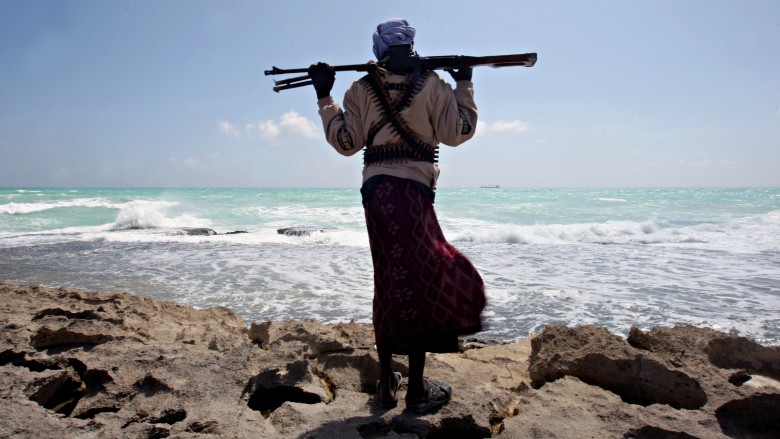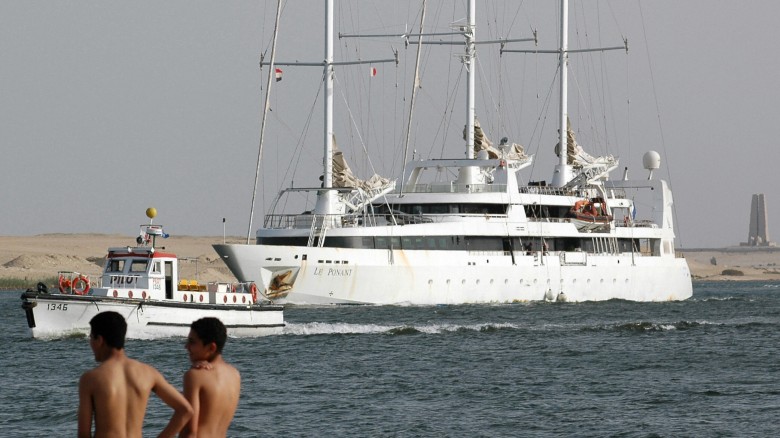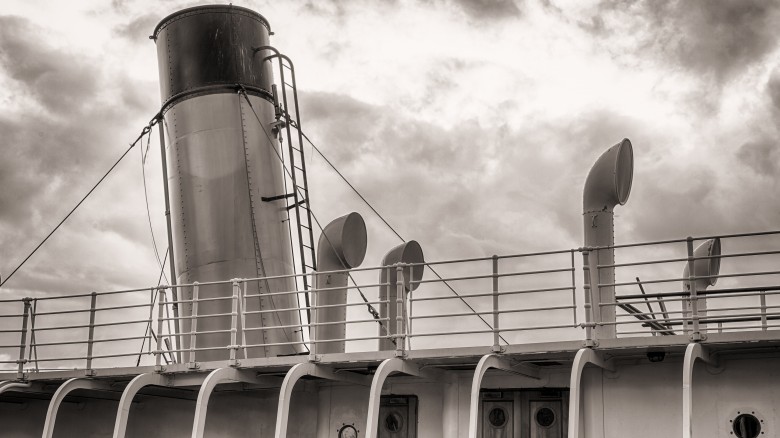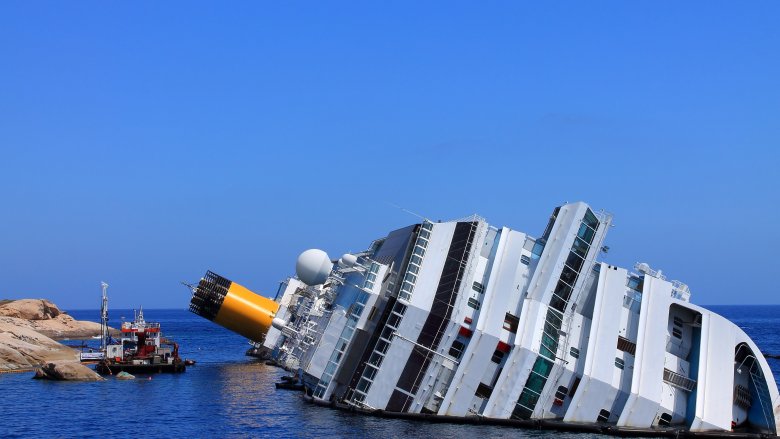The Real Stories Behind Scary Cruise Disasters
Need to get away from it all? Want to take a vacation from your problems? Well, perhaps you should book passage on a cruise ship. Or then again ... perhaps not. Cruise ships are basically floating disaster zones just waiting to happen, and over the years, thousands of unlucky passengers and crew members have found themselves at the mercy of pirates, nature, and incompetent captains.
The Carnival Triumph cruise from hell
The Carnival Triumph was anything but. On February 10, 2013, a fire broke out in one of the engine rooms, knocking out the ship's power and condemning the 3,143 passengers to endure the cruise from hell. The blaze began courtesy of a leaky fuel line, and making things worse, only four of the Triumph's six generators were working in the first place. Now, they were all fried, and the boat found itself without some pretty basic amenities, such as air conditioning, working lights, and a functional sewer system.
This is where the story starts to get pretty nasty. Stuck at sea for five days, the passengers were forced to use biohazard bags to store their, well, waste. According to reports, the decks were jam-packed with these bags. The stench coupled with the heat made things absolutely unbearable. Hoping for some sort of reprieve, the passengers camped out on the open decks and hallways, desperate for a bit of cool air.
Eventually, four tugboats towed the so-called "poop cruise" from its position off the Yucatan Peninsula to Mobile, Alabama. Although, there were a few hiccups, with a tow line and some tugboat equipment breaking along the way. As to why the cruise line didn't have the passengers switch over to another ship, that scenario would've been much too risky. In the grand scheme of things, five days isn't too long to wait for a safe trip home, even if the smell is unbearable.
Hoping to make up for the nightmare, the cruise line gave its passengers a refund, an extra $500 per person, and best of all, a free future cruise. We can't say for sure, but chances are good most people didn't take them up on that offer.
The attack on the Seabourn Spirit
Modern-day pirates are not a jolly bunch. Instead of peglegs and parrots, they're notorious for packing AK-47s and rocket-propelled grenades (RPGs). Many of these 21st century buccaneers work out of Somalia, looting any ship that tries to sneak by. And in November 2005, a group of Somali pirates decided it was a good idea to attack the Seabourn Spirit, a cruise ship carrying around 300 people. But as the cutthroats approached their target, they quickly realized they'd picked the wrong ship.
The Seabourn Spirit was heading for Mombasa, Kenya, when the crew noticed two boats were heading their direction. That's when Ship Security Officer Michael Groves went into superhero mode. The 41-year-old ex-cop ran up on deck and was almost immediately knocked down by an RPG blast. After making sure he still had all his digits, he fired at the pirates with a high-powered hose, forcing the Somalis to back off.
Of course, the pirates weren't giving up so easily, and soon they were back for round two. This time, the liner's Master of Arms, a Gurkha named Som Bahadur Gurung, decided to go sci-fi on the swashbucklers. Under fire, Gurung tried to blast the pirates with a Long Range Acoustic Device (LRAD), a sonic cannon that can cause serious hearing damage. But as he tried to fire, Gurung took a bullet, dropping him instantly. Fortunately, Groves pulled his comrade to safety and began firing the LRAD at the pirates, causing the outlaws to beat a hasty retreat.
For their bravery, Groves and Gurung were presented to Queen Elizabeth, who awarded Groves with the Queen's Gallantry Medal and Gurung with the Queen's Commendation for Bravery. They also found themselves armed with one great story to tell at parties.
The hijacking of Le Ponant
A swanky ship called Le Ponant was between jobs and only carrying its 30 crew members when it sailed through the Gulf of Aden in 2008. The Gulf is prime pirate territory, so the crew readied itself accordingly, with pirate-repelling fire hoses and lookouts at port and starboard. Before the ship could make it safely out of the Gulf, it was attacked by a team of eight pirates.
When he spotted the pirate crafts coming his way, Captain Patrick Marchesseau ordered the crew to prepare for battle, but the veteran pirates expertly avoided his fire hoses and line traps (meant to tangle up their motors). Pulling up alongside the ship, the Somalis hooked a ladder to the side of the boat, and when Le Ponant's doctor tried to knock the ladder off, the pirates began firing their machine guns. Soon, the Somalis were in charge, and the situation was made even more intense because the pirates were high on a stimulant called khat.
Luckily, the jittery pirates were only interested in money, and they directed Marchesseau to head for Somalia. Thinking on his feet, Marchesseau surreptitiously phoned CMA CGM, the Marseille-based company that owned Le Ponant, to let them know about the hijacking. Soon, the situation was being monitored by both the French and Canadian militaries, but this didn't deter the pirates for even one second.
As planned, Le Ponant anchored off the coast of Somalia, and soon, there were approximately 30 thugs on board, discussing how much ransom money they should demand. The pirates figured the crew was worth $3 million, but the folks at CMA CGM actually began haggling with the Somalis, convincing them to lower their price to $2.15 million. When all was said and done, the Somalis exchanged their prisoners for cash, and most of the outlaws escaped.
However, French helicopters chased down one vehicle carrying at least three confirmed pirates, and after shooting out the engine, the Somalis were taken into custody. Unfortunately, these three only possessed a fraction of the ransom money. The rest of the pirate band had disappeared, vanishing with the haul of a lifetime.
The disappearance of Rebecca Coriam
When you board a Disney cruise ship, you're hoping to find the happiest place on the ocean. But in 2011, things went from magical to mysterious when a Disney employee seemingly vanished off the face of the Earth.
Rebecca Coriam was a Youth Activity worker on Disney Wonder, a cruise ship taking tourists down the coast of Mexico. On March 22, 2011, the 24-year-old British citizen was caught on CCTV footage, talking on the telephone, appearing quite distraught. After hanging up and walking away, it was like Coriam stepped into another dimension. Hours later, after failing to report for work, Disney officials began searching the boat, but to no avail. Soon, both Mexican and American authorities were notified, and as Disney Wonder was registered in the Bahamas, a Bahamian official was sent to investigate.
The results were inconclusive. According to the investigator, it's likely Coriam was knocked off Deck Five of the ship by a wave. However, there's no CCTV footage of anyone falling overboard. Plus, journalist Jon Ronson wrote that it was unlikely she fell off Deck Five as a high steel wall would've prevented any such accident. And while some theorize she committed suicide, there are others—including high-ranking British politicians—who believe Coriam was murdered and possibly sexually assaulted. Some have even alleged that Disney knew of the killing and kept it quiet.
As for Coriam's family, they still hold out hope that Coriam is alive somewhere, but while they asked both the FBI and President Barack Obama for assistance, there haven't been any concrete answers. In 2016, the family reached an undisclosed settlement with Disney, perhaps ending the entire, enigmatic saga. Although there is one bit of additional info which makes the story stranger still: two months after after Rebecca Coriam disappeared, someone used her credit card.
The sinking of the SS Arctic
It was September 1854, and the steam-powered SS Arctic had recently left England, full of American tourists returning home. Near the Grand Banks of Newfoundland, the ship found itself plowing through dense fog, and instead of slowing down, Captain James Luce gave his paddle steamer, well, more steam.
As an employee of the Collins Line, Luce was simply following company policy. The idea was the faster you go, the sooner you're out of the fog. Evidently, the captain aboard the Vesta, a French steamer, had a similar idea, so the two ships were going pretty fast when they rammed into one another.
At first, everyone thought the Vesta was in worse trouble, so passengers began paddling to the Arctic for safety. But it quickly became apparent that the iron-huddled French ship had absolutely destroyed the Arctic's wooden hull. As the American ship turned on its side, Luce ordered the ship to head for land, but as it chugged along, the boat quickly filled up with water. Soon, the Atlantic Ocean had washed into the furnaces, leaving the Arctic dead in the water.
That's when things descended into anarchy. The crew freaked out and abandoned most of the passengers, escaping in the lifeboats, and in the ensuing madness, many of these boats were capsized or destroyed. Now, the numbers are fuzzy, but of the approximately 400 people on board, it seems less than 90 survived. None of the women and children made it off the boat alive.
As you might've guessed, this tragedy marked the beginning of the end for the Collins Line, and perhaps the idea of Victorian gallantry, as well. If chivalry is dead, then maybe the SS Arctic killed it.
The Eastland tragedy
In 1912, the RMS Titanic famously struck an iceberg and went down in the North Atlantic. In total, 829 passengers were lost at sea. Then in 1915, in another well-known tragedy, the RMS Lusitania was torpedoed by a German submarine, claiming the lives of 785 passengers. But just a few weeks later, the SS Eastland topped both the Titanic and the Lusitania in a horrific accident that ended with hundreds of passengers floating lifelessly in Lake Michigan.
The date was July 24, and it was supposed to be a great day for the employees of the Western Electric Company. The Eastland had been chartered to ferry workers and their families from Chicago to a nice park across the lake, where they could spend the day eating, playing, and hanging out with friends and relatives.
In total, there were over 2,500 people aboard the ship, and on top of that, the Eastland was loaded down with lifeboats ... too many lifeboats. Even worse, all this extra weight was stored in the upper decks of the ship, making the Eastland incredibly top-heavy. Throw into the mix that the ship had a history of a nearly capsizing, and now you've got a surefire recipe for disaster.
According to Smithsonian magazine, the vessel began to list before it was even untied from the dock. In a matter of minutes, the Eastland had turned on its side, causing complete mayhem. Water began flooding into the ship, passengers were forced to dodge pianos and refrigerators—some unsuccessfully—and almost everyone on the upper decks was hurled into Lake Michigan. In total, 844 passengers died that fateful day, an absolute tragedy made worse because around 75% of the victims were younger than 25-years-old.
The Costa Concordia disaster
You know how the captain is supposed to go down with his ship? Evidently, Francesco Schettino didn't get that memo. In January 2012, the Italian captain was in charge of the Costa Concordia (above), a ship carrying over 4,000 people. As the vessel passed the Tuscan island of Giglio, Schettino decided to get a closer look. Like, a lot closer.
Evidently, the captain steered the ship so close to the island that the Costa Concordia was less than 1,000 feet away from land. According to Schettino, he meant this as a respectful "salute" to Giglio. According to authorities, he was actually trying to impress his girlfriend.
Whatever the reason, the Costa Concordia ran into trouble when it smashed into a rock. As Popular Mechanics put it, the wreck left a hole the length of an "Olympic-size swimming pool" in the port side. The ocean began flooding in, killing the generators and causing the vessel to list. Schettino then ordered the crew to tell the passengers they were simply having electrical issues. The crew complied, but in fairness, most of them didn't know what was happening either.
Eventually, the Costa Concordia hit the shore and began to seriously roll. It was here—over an hour after hitting the rock—that Schettino ordered an evacuation. This was no easy task, as the passengers hadn't yet been told where to find the lifeboats. Complicating things further, the ship was seriously tilted, making escape difficult. But then, in a shocking turn of events, Schettino sailed away in a lifeboat, leaving hundreds of passengers behind.
In total, 32 people died in the disaster, and Captain Schettino was found guilty of manslaughter. He was sentenced to 16 years behind bars, possibly for trying to wow his girlfriend. We're pretty sure she wasn't impressed.
The Achille Lauro hijacking
It was October 1985, and the Italian cruise ship, Achille Lauro, was floating near Alexandria, Egypt, when four passengers pulled out machine guns and took over the boat. They were members of the Palestine Liberation Front, and they wanted the state of Israel to free 50 Palestinian militants. If Israel didn't comply, they threatened to kill all the American and British citizens on board, and if anyone tried to stop them, they would blow up the ship.
The terrorists then ordered the ship to sail for Syria, but when the Syrian government refused to let them dock, the militants decided it was time to send a message. The group grabbed a 69-year-old Jewish-American, wheelchair-bound man named Leon Klinghoffer, shot him in the head and tossed him over the side of the ship. Shortly after the execution, Egyptian officials convinced the group to surrender, in exchange for an airplane ride to freedom. But before the terrorists could make their escape, American fighter jets forced their getaway plane to land at a NATO base in Sicily.
While they'd committed murder, the terrorists all got off with surprisingly light sentences. Three were given between 15 to 30 years in prison, while the fourth was convicted separately from the bunch because he was a minor. Believe it or not, the whole bloody incident inspired an opera called The Death of Klinghoffer which raised quite a bit of controversy when it finally made its way to the stage. Yeah, ya think?
The SS Morro Castle fire
When the Morro Castle set sail in September 1934, it was cruising straight into disaster. First, Captain Robert Wilmott mysteriously died of a "heart attack and nervous stomach." Then, with unprepared Acting Captain William Warms in charge, the ship was hit by a violent gale. Making things worse, as winds battered the ship, a fire broke out in the Morro Castle's writing room. Soon, the blaze spread across the vessel, devastating the ship and killing 135 people.
Shortly after the fire, the Morro Castle ran aground on the New Jersey shore, but in the middle of all the tragedy, a hero emerged from the ashes. His name was George White Rogers, and he served as the ship's chief radio engineer. As smoke billowed across the ship, he sat at his radio and bravely sent out SOS distress messages. After the fire, Rogers became something of a national hero and even spoke about his heroic actions on Broadway. But if you dig a little deeper, it turns out that Rogers might not be so courageous after all.
You see, Rogers was something of a lifelong criminal. Before stepping on the Morro Castle, he was a rapist, a thief, and a dog-poisoner. Afterward, he tried opening a radio store in Bayonne, New Jersey, but when the enterprise proved to be unsuccessful, the store mysteriously burned down. Next, he got a gig working as a radioman at the Bayonne Police Department, but he was arrested after trying to murder a coworker with an explosive device. Then after he was released from prison, Rogers took a loan from a man named William Hummel, and when the guy wanted his money back, Rogers murdered both Hummel and his daughter with a sledgehammer.
In 1954, the hero of the Morro Castle was sentenced to life in prison, though he died after four years behind bars. His passing left a great number of questions unanswered. Did this psychotic criminal set fire to the Morro Castle? Did he murder Captain Robert Wilmott? It seems we may never know for sure.
But the answer is yeah, probably.




